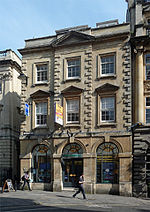Former Bristol and West Building

The former Bristol and West Building on Marsh Street/St Augustine's Parade, Bristol and facing onto The Centre, was built in 1967 by Alec French and partners.Rising 61 metres with 17 stories, the building was formerly used as the headquarters of the Bristol and West until early 2006. It was clad in granite-chipped pre-cast concrete.In the early 2000s plans to demolish and replace with a 23-storey building, the tallest in Bristol, were proposed, but rejected. Since then, major renovations have been carried out, including re-cladding in blue-tinted glass panels of different shades to give the illusion the building merges into the sky. After several delays the building reopened in May 2009 as a 176-room hotel operated by Radisson SAS. In addition to the hotel, the site also includes residential apartments and shops.
Excerpt from the Wikipedia article Former Bristol and West Building (License: CC BY-SA 3.0, Authors, Images).Former Bristol and West Building
Broad Quay, Bristol City Centre
Geographical coordinates (GPS) Address Phone number Website External links Nearby Places Show on map
Geographical coordinates (GPS)
| Latitude | Longitude |
|---|---|
| N 51.4524 ° | E -2.5966 ° |
Address
Radisson Hotel Blu
Broad Quay
BS1 4BY Bristol, City Centre
England, United Kingdom
Open on Google Maps










